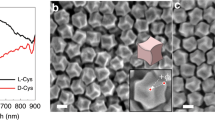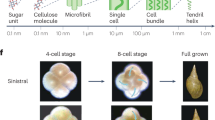Abstract
Homochirality is an important feature in biological systems and occurs even in inorganic nanoparticles. However, the mechanism of chirality formation and the key steps during growth are not fully understood. Here we identify two distinguishable pathways from achiral to chiral morphologies in gold nanoparticles by training an artificial neural network of cellular automata according to experimental results. We find that the chirality is initially determined by the nature of the asymmetric growth along the boundaries of enantiomeric high-index planes. The deep learning-based interpretation of chiral morphogenesis provides a theoretical understanding but also allows us to predict an unprecedented crossover pathway and the resulting morphology.
This is a preview of subscription content, access via your institution
Access options
Access Nature and 54 other Nature Portfolio journals
Get Nature+, our best-value online-access subscription
$29.99 / 30 days
cancel any time
Subscribe to this journal
Receive 12 print issues and online access
$259.00 per year
only $21.58 per issue
Buy this article
- Purchase on Springer Link
- Instant access to full article PDF
Prices may be subject to local taxes which are calculated during checkout




Similar content being viewed by others
Data availability
All the data for reproduction of this study are available via Github at https://github.com/sangwonim/gca-chiral-morphogenesis. Additional data related to the paper are available from the corresponding authors upon reasonable request.
Code availability
The code for the GCA model is included in the Supplementary Information and available via Github at https://github.com/sangwonim/gca-chiral-morphogenesis and via Zenodo at https://doi.org/10.5281/zenodo.10872052 (ref. 47).
References
Blackmond, D. G. Asymmetric autocatalysis and its implications for the origin of homochirality. Proc. Natl Acad. Sci. USA 101, 5732–5736 (2004).
Mann, S. Molecular recognition in biomineralization. Nature 332, 119–124 (1988).
Lebreton, G. et al. Molecular to organismal chirality is induced by the conserved myosin 1D. Science 362, 949–952 (2018).
Tee, Y. H. et al. Cellular chirality arising from the self-organization of the actin cytoskeleton. Nat. Cell Biol. 17, 445–457 (2015).
Grande, C. & Patel, N. H. Nodal signalling is involved in left-right asymmetry in snails. Nature 457, 1007–1011 (2009).
Thitamadee, S., Tuchihara, K. & Hashimoto, T. Microtubule basis for left-handed helical growth in Arabidopsis. Nature 417, 193–196 (2002).
Sharma, V., Crne, M., Park, J. O. & Srinivasarao, M. Structural origin of circularly polarized iridescence in jeweled beetles. Science 325, 449–451 (2009).
Bouligand, Y. Twisted fibrous arrangements in biological materials and cholesteric mesophases. Tissue Cell 4, 189–217 (1972).
Orme, C. A. et al. Formation of chiral morphologies through selective binding of amino acids to calcite surface steps. Nature 411, 775–779 (2001).
Hazen, R. M. & Sholl, D. S. Chiral selection on inorganic crystalline surfaces. Nat. Mater. 2, 367–374 (2003).
Shukla, N. & Gellman, A. J. Chiral metal surfaces for enantioselective processes. Nat. Mater. 19, 939–945 (2020).
Im, S. W. et al. Chiral surface and geometry of metal nanocrystals. Adv. Mater. 32, 1905758 (2020).
González-Rubio, G. et al. Micelle-directed chiral seeded growth on anisotropic gold nanocrystals. Science 368, 1472–1477 (2020).
Xu, L. et al. Enantiomer-dependent immunological response to chiral nanoparticles. Nature 601, 366–373 (2022).
Jiang, W. et al. Emergence of complexity in hierarchically organized chiral particles. Science 368, 642–648 (2020).
Kuzyk, A. et al. DNA-based self-assembly of chiral plasmonic nanostructures with tailored optical response. Nature 483, 311–314 (2012).
Yeom, J. et al. Chiromagnetic nanoparticles and gels. Science 359, 309–314 (2018).
Lee, H.-E. et al. Amino-acid- and peptide-directed synthesis of chiral plasmonic gold nanoparticles. Nature 556, 360–365 (2018).
Kim, R. M. et al. Enantioselective sensing by collective circular dichroism. Nature 612, 470–476 (2022).
Talapin, D. V., Rogach, A. L., Haase, M. & Weller, H. Evolution of an ensemble of nanoparticles in a colloidal solution: theoretical study. J. Phys. Chem. B 105, 12278–12285 (2001).
Xiao, R.-F., Alexander, J. I. D. & Rosenberger, F. Morphological evolution of growing crystals: a Monte Carlo simulation. Phys. Rev. A 38, 2447–2456 (1988).
Turner, C. H., Lei, Y. & Bao, Y. Modeling the atomistic growth behavior of gold nanoparticles in solution. Nanoscale 8, 9354–9365 (2016).
Müller, M. & Albe, K. Lattice Monte Carlo simulations of FePt nanoparticles: influence of size, composition, and surface segregation on order-disorder phenomena. Phys. Rev. B 72, 094203 (2005).
Damasceno, P. F., Engel, M. & Glotzer, S. C. Predictive self-assembly of polyhedra into complex structures. Science 337, 453–457 (2012).
Zhang, D., Choi, C., Kim, J. & Kim, Y. M. Learning to generate 3D shapes with generative cellular automata. In 9th International Conference on Learning Representations (ICLR) (2021).
Mordvintsev, A., Randazzo, E., Niklasson, E. & Levin, M. Growing neural cellular automata. Distill https://doi.org/10.23915/distill.00023 (2020).
Von Neumann, J. & Burks, A. W. Theory of Self-Reproducing Automata (Univ. Illinois Press, 1966).
Gardner, M. Mathematical games: the fantastic combinations of John Conway’s new solitaire game “life”. Sci. Am. 223, 120–123 (1970).
Wootton, J. T. Local interactions predict large-scale pattern in empirically derived cellular automata. Nature 413, 841–844 (2001).
Manukyan, L., Montandon, S. A., Fofonjka, A., Smirnov, S. & Milinkovitch, M. C. A living mesoscopic cellular automaton made of skin scales. Nature 544, 173–179 (2017).
Kim, H. et al. γ-Glutamylcysteine- and cysteinylglycine-directed growth of chiral gold nanoparticles and their crystallographic analysis. Angew. Chem. Int. Ed. 59, 12976–12983 (2020).
Cho, N. H. et al. Uniform chiral gap synthesis for high dissymmetry factor in single plasmonic gold nanoparticle. ACS Nano 14, 3595–3602 (2020).
Lee, H.-E. et al. Cysteine-encoded chirality evolution in plasmonic rhombic dodecahedral gold nanoparticles. Nat. Commun. 11, 263 (2020).
Zhang, N.-N., Sun, H.-R., Xue, Y., Peng, F. & Liu, K. Tuning the chiral morphology of gold nanoparticles with oligomeric gold–glutathione complexes. J. Phys. Chem. C 125, 10708–10715 (2021).
Wang, S. et al. Helically grooved gold nanoarrows: controlled fabrication, superhelix, and transcribed chiroptical switching. CCS Chem. 3, 2473–2484 (2020).
Ni, B. et al. Chiral seeded growth of gold nanorods into 4-fold twisted nanoparticles with plasmonic optical activity. Adv. Mater. 35, 2208299 (2022).
Wang, H. et al. Selectively regulating the chiral morphology of amino acid-assisted chiral gold nanoparticles with circularly polarized light. ACS Appl. Mater. Interfaces 14, 3559–3567 (2022).
Graham, B., Engelcke, M. & Maaten, L. 3D semantic segmentation with submanifold sparse convolutional networks. In 2018 IEEE/CVF Computer Vision and Pattern Recognition (CVPR) 9224–9232 (2018).
Bordes, F., Honari, S. & Vincent, P. Learning to generate samples from noise through infusion training. In 5th International Conference on Learning Representations (ICLR) (2017).
Ahn, H.-Y., Lee, H.-E., Jin, K. & Nam, K. T. Extended gold nano-morphology diagram: synthesis of rhombic dodecahedra using CTAB and ascorbic acid. J. Mater. Chem. C 1, 6861–6868 (2013).
Wu, H.-L. et al. A comparative study of gold nanocubes, octahedra, and rhombic dodecahedra as highly sensitive SERS substrates. Inorg. Chem. 50, 8106–8111 (2011).
Zhang, D., Choi, C., Park, I. & Kim, Y. M. Probabilistic implicit scene completion. In 10th International Conference on Learning Representations (ICLR) (2022).
Paszke, A. et al. PyTorch: an imperative style, high-performance deep learning library. In 33rd Conference on Neural Information Processing Systems (NeurIPS) (2019).
Choy, C., Gwak, J. & Silvio, S. 4D Spatio-temporal ConvNets: Minkowski convolutional neural networks. In 2019 IEEE/CVF Conference on Computer Vision and Pattern Recognition (CVPR) 3075–3084 (2019).
Kingma, D. P. & Ba, J. Adam: a method for stochastic optimization. In 3rd International Conference for Learning Representations (ICLR) (2015).
Ronneberger, O., Fischer, P. & Brox, T. U-Net: convolutional networks for biomedical image segmentation. In Medical Image Computing and Computer-Assisted Intervention – MICCAI 2015 234–241 (Springer, 2015).
Im, S. W. & Zhang, D. Sangwonim/gca-chiral-morphogenesis: v1.0. Zenodo https://doi.org/10.5281/zenodo.10872052 (2024).
Acknowledgements
This work is supported by the Defense Challengeable Future Technology Program of Agency for Defense Development, Republic of Korea (S.W.I., J.H.H., R.M.K. and K.T.N.); Korea Institute for Advancement of Technology (KIAT) grant P0019783 (S.W.I., J.H.H., R.M.K. and K.T.N.) funded by the Korean government (Ministry of Trade, Industry and Energy (MOTIE)); and the National Research Foundation of Korea (NRF) grant NRF-2020M3F7A1094300 (C.C. and Y.M.K.) funded by the Korean government (Ministry of Science and ICT (MSIT)). K.T.N. thanks the Institute of Engineering Research, Research Institute of Advanced Materials (RIAM) and SOFT Foundry Institute.
Author information
Authors and Affiliations
Contributions
K.T.N. and Y.M.K. conceived the project. S.W.I. and D.Z. designed the experiments and implemented the GCA model. D.Z. and C.C. developed the GCA model. S.W.I., J.H.H. and R.M.K. synthesized and characterized the nanoparticles. J.H.H. conducted the FDTD simulations. S.W.I., D.Z., Y.M.K. and K.T.N. wrote the manuscript with contributions from all authors. Y.M.K. guided the numerical simulations. K.T.N. guided all aspects of the work.
Corresponding authors
Ethics declarations
Competing interests
The authors declare no competing interests.
Peer review
Peer review information
Nature Materials thanks Qian Chen, Zhifeng Huang and Jianping Xie for their contribution to the peer review of this work.
Additional information
Publisher’s note Springer Nature remains neutral with regard to jurisdictional claims in published maps and institutional affiliations.
Extended data
Extended Data Fig. 1 432 helicoid morphologies depending on sequences of an amino acid and peptides, and seed morphologies.
SEM images of 432 helicoids synthesized using a, Cys, b, Glu-Cys, c, Cys-Gly, d, Glu-Cys-Gly as chiral amino acid or peptide. (Scale bar: 200 nm) *Cys was injected after 20 min of cube seed growth.
Extended Data Fig. 2 Morphogenesis processes of 432 helicoids.
432 helicoids with different growth time were observed by SEM. (Scale bar: 200 nm) Each 432 helicoid start from a 20-30 nm low-Miller-index-faceted seed and evolves to a high-Miller-index-faceted intermediate morphology. Depending on the seed morphologies and peptide sequences, the chiral intermediates and final chiral features were determined.
Extended Data Fig. 3 Predicted \(4/m\bar{3}2/m\)- and 432-symmetric crystal morphologies.
a, Each crystal is assumed to be composed of one type of surface Miller index. A morphology of a crystal is determined by the orientation of red-indicated facet. Therefore, crystal morphologies can be corresponded to the stereographic projection of this facet. The type of morphology is distinguished by convexity, flatness, or concavity of three elementary edges connecting 〈100〉, 〈111〉, 〈110〉 vertices. b, Chiral morphologies are predicted by breaking mirror symmetry between adjacent facets of 7 different high-Miller-index-faceted morphologies that is theoretically predicted. Depending on the convexity or concavity of the edges, different chiral features appear.
Extended Data Fig. 4 Experimental confirmation of the crossover between RDH3 and CBH1 pathways.
a, Schematic description of growth pathways and crossovers discovered from GCA. Solid lines indicate possible pathways of RDH3, CBH1, and crossover from RDH3 to CBH1. Dotted line indicates impossible crossover from CBH1 to RDH3 b, H3 intermediate after growth in GSH-containing solution for 30 min. c, H3 after growth in GSH-containing solution for 120 min. d, H3 intermediate was injected to Cys-containing solution. H1 morphology with the chiral edge structure was obtained. e, H1 intermediate after growth in Cys-containing solution for 30 min. f, H1 after growth in Cys-containing solution for 120 min. g, H1 intermediate was injected to GSH- containing solution, but H1 morphology was remained. (Scale bar: 200 nm).
Supplementary information
Supplementary Information
Supplementary Figs. 1–14 and text.
Supplementary Code 1
Code for GCA.
Rights and permissions
Springer Nature or its licensor (e.g. a society or other partner) holds exclusive rights to this article under a publishing agreement with the author(s) or other rightsholder(s); author self-archiving of the accepted manuscript version of this article is solely governed by the terms of such publishing agreement and applicable law.
About this article
Cite this article
Im, S.W., Zhang, D., Han, J.H. et al. Investigating chiral morphogenesis of gold using generative cellular automata. Nat. Mater. (2024). https://doi.org/10.1038/s41563-024-01889-x
Received:
Accepted:
Published:
DOI: https://doi.org/10.1038/s41563-024-01889-x



